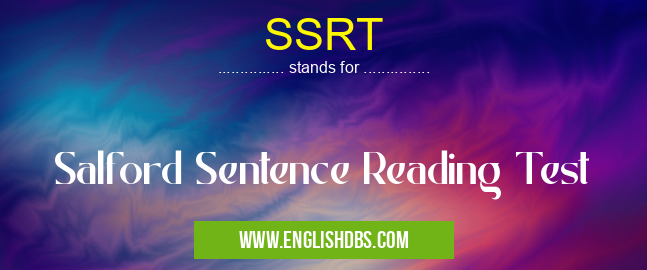What does SSRT mean in UNCLASSIFIED
SSRT stands for Salford Sentence Reading Test. It is a widely used assessment tool designed to measure an individual's reading fluency and comprehension skills. The test is particularly beneficial in identifying reading difficulties and providing insights into a person's reading speed and accuracy.

SSRT meaning in Unclassified in Miscellaneous
SSRT mostly used in an acronym Unclassified in Category Miscellaneous that means Salford Sentence Reading Test
Shorthand: SSRT,
Full Form: Salford Sentence Reading Test
For more information of "Salford Sentence Reading Test", see the section below.
Purpose of SSRT
The SSRT serves several purposes, including:
- Assessing reading fluency and comprehension
- Identifying reading disabilities and specific areas of difficulty
- Monitoring progress in reading intervention programs
- Providing a baseline for future reading assessments
Administration of SSRT
The SSRT is typically administered by a trained professional, such as a speech-language pathologist or reading specialist. The test involves the participant reading a series of sentences aloud while the examiner records the participant's reading time, errors, and comprehension.
Scoring of SSRT
The SSRT is scored based on several criteria, including:
- Reading speed (number of words read per minute)
- Reading accuracy (percentage of words read correctly)
- Reading comprehension (ability to understand and answer questions about the text)
Interpretation of SSRT
The SSRT results provide valuable information about an individual's reading skills. The examiner can compare the participant's performance to established norms to determine if the participant is reading at an expected level for their age and grade. The results can also help identify specific areas of difficulty that require additional support.
Essential Questions and Answers on Salford Sentence Reading Test in "MISCELLANEOUS»UNFILED"
What is the Salford Sentence Reading Test (SSRT)?
The SSRT is a standardized reading test used to assess reading accuracy and speed. It is designed to be administered individually or in groups and is commonly used in clinical and educational settings to diagnose and monitor reading difficulties.
Who is the SSRT appropriate for?
The SSRT is suitable for individuals from ages 6 to 80 years old. It is particularly useful for assessing children and adults with suspected reading difficulties, including dyslexia and developmental language disorders.
What does the SSRT measure?
The SSRT measures reading fluency, which encompasses both accuracy and speed. It assesses the ability to read sentences aloud correctly and quickly, providing insights into word recognition, decoding, and comprehension skills.
How is the SSRT administered?
The SSRT is typically administered by a trained examiner. The examiner presents the participant with a series of sentences to read aloud. The examiner notes the time it takes to read each sentence and records any errors made.
How are SSRT results interpreted?
The examiner compares the participant's SSRT score to normative data for their age and grade level. The results can indicate whether the individual's reading fluency is within the expected range or if they may have difficulties in this area.
What are the benefits of using the SSRT?
The SSRT is a widely used and reliable tool for assessing reading fluency. It provides objective data that can help professionals identify individuals with reading difficulties and develop appropriate intervention plans.
Final Words: The SSRT is a reliable and valid assessment tool that provides comprehensive insights into an individual's reading abilities. It is widely used in educational and clinical settings to identify reading difficulties, monitor progress, and guide intervention programs. By understanding the SSRT meaning, educators and clinicians can tailor interventions to address specific reading challenges and help individuals improve their overall literacy skills.
